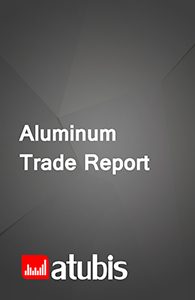Oman’s Aluminum Extrusions Market Outlook Report
9,759€
- TRY: 475,000 ₺
Thanks to their various shapes, aluminum extrusions have wide applications in different industries. Among the consumer industries, the construction sector is the largest consumer of extrusions in curtain walls and aluminum doors and windows. Due to Oman’s hot climate, the construction industry has moved towards using more insulation products, such as curtain walls and double-glazed doors and windows, which will not only minimize energy loss, but also have much lower installation costs in tall, big buildings compared to other types of façade.
Product Description
With a per-capita GDP of $32,400 in 2019, Oman was the fifth largest economy in the region that year, behind Qatar, the United Arab Emirates, Bahrain, and Saudi Arabia. The country’s economy has steadily grown over the past years, and according to the Oman Vision 2040, economic growth is expected to continue over the coming years. The country’s logistical location that connects the Gulf Cooperation Council (GCC) countries to the world is one of the major factors in expanding its relations and trade with other countries; the free trade agreement with the US since 2009 is one example. Oil and petrochemicals account for a major portion of the country’s exports. In 2019, about 70% of the country’s total export revenues came from oil and oil-related products. Iron and steel as well as organic chemicals are also major contributors to the country’s total exports. The aluminum industry has moved up to the fifth place in the country’s exports and has had significant growth and development in downstream capacities over the recent years. A considerable portion of downstream capacities are located near the country’s primary smelter Sohar, which has an annual capacity of 375 thousand tonnes; this makes hot metal easily available to downstream producers, reducing their costs.
Market drivers of Oman’s aluminum extrusions
Oman’s construction industry has been growing over the years and many have forecast more brisk growth in the coming years. Estimates suggest that the country’s construction industry has grown 3.4% on average per year over the past five years, which is expected to increase significantly over the next five years to reach 10%. Since the construction sector is the major consumer of aluminum extrusions in Oman, demand for these products is expected to grow as construction is further developed.
Double-glazed doors and windows are among major consumers of aluminum extrusions. The quality and visual appeal of aluminum doors and windows compared to PVC ones have supported demand and are expected to continue to do so. But the growth might slow down during periods of bearish markets and low liquidity.
Oman reported its first case of Covid-19 in late March 2020. Before long, in April, social distancing and lockdowns were implemented. As a result, the country’s mobility index dropped more than 30%. As the pandemic continued to spread, lockdowns were extended into mid-April, but activities were gradually resumed under certain protocols. Lockdowns are expected to continue, significantly disrupting industrial performance and eventually leading to a decline in demand for aluminum semis; a recovery might be likely in the near term.
Overview of Oman’s aluminum extrusions market
Oman’s National Aluminium Products Company (NAPCO) is the main producer of aluminum extrusions in the country. Extrusions output has grown over the recent years; the country has transitioned from a net importer to a net exporter. However, the gradual development of extrusion capacities in most overseas markets will put pressure on extrusion sales outside the country. That, combined with the development of the construction sector and stronger demand for aluminum extrusions over the coming years, will dampen exports. Yet, the country is expected to remain a net exporter in the region in the medium term.
Breakdown of Oman’s aluminum extrusions market
Domestic demand for aluminum extrusions in the forecast timeframe as well as the previous period has been broken down using three factors. The first factor breaks down the market into three categories based on alloy material: commercially pure aluminum, heat-treatable alloys, and non-heat-treatable alloys. Past and future trends for each type of material have been analyzed. Heat-treatable alloys hold the largest share of the market. In the second breakdown, products are divided into two categories based on product type: hollow and solid products. Solid extrusions hold the largest share of the market. Finally, using the third factor, aluminum extrusions are categorized based on their applications in different industries. The construction sector is the largest consumer of aluminum extrusions in Oman.
Key players in Oman’s aluminum extrusions market:
- National Aluminium Products Company SAOG (NAPCO)
- Shanfari Aluminum Co. LLC
Additional Information
| Industry | Aluminium Longs |
|---|---|
| Region | Oman |
| Report Type | Industry Report |
Specifications
| Report Attribute | Details |
| The base year for estimation | 2019 |
| Historical data | 2009-2018 |
| Forecast period | 2020-2025 |
| Quantitative units | Value in USD and Volume in Tonne |
| Report coverage | Market Overview, Dynamics, Market Outlook, Risks to Forecast, Consumer Market, Industry Overview, Market Landscape, Competitive Landscape, Market Attractiveness, External Macro Environment Analysis |
| Segments covered | Composition, Type, Application |
| Pricing and purchase options | Please explore our purchase options to meet your exact research needs. |
Reasons to Buy
- Recognize the geographical distribution of import demand
- Identify the current and future key players of the trading market
- Achieve a better insight on potential target markets
- Understand the behavior of major suppliers/customers either globally or regionally
- Identify competitors as a feed for market analysis
Table of Content
- Executive summary
- Introduction
- Objective
- Market under study
- Product
- Product specifications
- Consumption structure
- Applications
- Physical properties
- Subjects discussed
- Geographical scope under study
- Study timeframe
- Study currency
- Potential audience
- Market dynamics
- Market drivers
- Restraints
- Opportunities
- Challenges
- Market overview
- Market size
- Industry capacities
- Existing capacities
- Capacity distribution
- Geographical distribution of capacities
- Future capacities
- Existing capacities
- Output
- Output trends
- Operating rates
- Consumption
- Consumption trend
- Consumption Share of domestic product
- Trade
- Exports
- Imports
- Trade balance
- Market balance
- Market breakdown by product type
- Market breakdown by product type
- Market breakdown by application
- Inventory
- Producers inventory
- Consumers inventory
- Traders inventory
- Market outlook
- Market factors
- Raw materials
- Costs and prices
- Competition
- The government
- Other factors
- Future scenarios
- Risks to forecast
- Market factors
- Consumer markets
- End-user markets
- Building construction
- Infrastructure construction
- Transportation manufacturing
- Industrial equipment manufacturing
- Durable goods manufacturing
- Consumable goods manufacturing
- Direct consumer markets
- Major Direct consumers
- Existing capacities
- Drivers
- Major Direct consumers
- End-user markets
- Export potentials
- Destinations
- Trade and insurance costs
- Import market suppliers
- Producers potential share
- Destinations
- Industry overview
- Raw materials
- The supply volume of raw materials
- Supply channels of raw materials
- Raw materials procurement costs
- Cost structure of producers
- Production cost curve
- Industry value added
- Generated new scrap
- Technology
- Raw materials
- Market landscape
- Domestic sales markets
- Pricing in the domestic market
- Potential domestic demand
- Trade agreements for imports
- Foreign suppliers
- Foreign sales market
- Prices
- Potential markets overview
- Trade agreements for exports
- Foreign customers
- Domestic sales markets
- Competitive landscape
- Producers
- Company profile
- Revenue structure
- Gross profit margins
- Capacity, output and sales
- Consumers
- Company profile
- Revenue structure
- Gross profit margins
- Capacity, output and sales
- Producers
- Market attractiveness
- Industry rivalry
- Threat of new entrants
- Threat of substitutes
- Bargaining power of buyers
- Bargaining power of suppliers
- Conclusion of Porter analysis
- PESTEL analysis
- Political factors
- Economic factors
- Social factors
- Technology factors
- Environmental factors
- Legal factors
- SWOT analysis
- Large-scale companies with favorable conditions
- Short-term strategies
- Long-term strategies
- Large-scale companies with unfavorable conditions
- Short-term strategies
- Long-term strategies
- Small enterprises with favorable conditions
- Short-term strategies
- Long-term strategies
- Small enterprises with unfavorable conditions
- Short-term strategies
- Long-term strategies
- Large-scale companies with favorable conditions
List of Figures
- Output and consumption; 2009-2018
- Market share of product applications; 2018
- Market surplus; 2019-2025
- Production process flowchart
- Market size; 2009-2025
- Existing capacity; 2009-2018
- Capacity distribution; 2018
- Geographic distribution of capacities; 2018
- Development of future capacity; 2009-2025
- Amount of output; 2009-2025
- Operating rates of production plants; 2009-2025
- Amount of consumption; 2009-2025
- Consumption share of domestic product; 2009-2025
- Exports of product; 2009-2018
- Imports of product; 2009-2018
- Historical trade balance; 2009-2018
- Future Market balance; 2021-2025
- Market output breakdown by alloy type; 2009-2025
- Market consumption breakdown by alloy type; 2009-2025
- Market balance breakdown by alloy type; 2009-2025
- Market output breakdown by product type; 2009-2025
- Market consumption breakdown by product type; 2009-2025
- Market balance breakdown by product type; 2009-2025
- Market consumption breakdown by application; 2009-2025
- Inventories of raw materials and products at producers factories; 2009-2018
- Consumers’ inventory of product; 2009-2018
- Traders’ inventory; 2009-2018
- Production forecast, according to raw materials and sales analysis; 2019-2025
- Market surplus; 2019-2025
- The share of end-user industries in the consumption; 2009 and 2018
- Changes in the end-consumption of extrusion products; 2018 vs 2025
- Applications in building construction industry; 2018
- Applications in infrastructure construction industry; 2018
- Applications in transportation manufacturing industry; 2018
- Applications in industrial equipment manufacturing industry; 2018
- Applications in durable goods manufacturing industry; 2018
- Applications in consumable goods manufacturing industry; 2018
- Capacity distribution structure of direct consumers; 2018
- Existing capacities of direct consumers in each province; 2018
- Suppliers of the export potential destination; 2018
- Historical exports to the export potential destination and future potential; 2016-2025
- Up-stream domestic supply; 2009-2018
- Raw materials domestic supply; 2009-2018
- Supply channels of producer plants
- Spot price of raw material in the market; 2009-2025
- Cash cost structure for production the product; 2018
- Production cost curve of the plants; 2018
- Gross value added of the industry; 2009-2018
- Generated new scrap; 2009-2018
- Sales channels
- Realized price of the product in the market; 2009-2025
- Potential demand of each province; 2018
- The main foreign suppliers to the market; 2009-2018
- FOB price vs domestic market; 2009-2025
- Map of global major importers > 20,000t; 2018
- Major foreign customers; 2009-2018
- Revenue structure of the producers; FY2018
- Sales income and gross profit margin of the producers; FY2009-2018
- Output and sales of the producers; FY2009-2018
- Revenue structure of the consumers; FY2018
- Sales income and gross profit margin of the consumers; FY2009-2018
- Output and sales of the consumers; FY2009-2018
- SWOT matrix for large-scale companies with favorable conditions
- Strategies positioning for large-scale companies with favorable conditions
- SWOT matrix for large-scale companies with unfavorable conditions
- Strategies positioning for large-scale companies with unfavorable conditions
- SWOT matrix for small enterprises with favorable conditions
- Strategies positioning for small enterprises with favorable conditions
- SWOT matrix for small enterprises with unfavorable conditions
- Strategies positioning for small enterprises with unfavorable conditions



